Guizhi-Shaoyao-Zhimu decoction attenuates rheumatoid arthritis partially by reversing inflammation-immune system imbalance
- PMID: 27277474
- PMCID: PMC4898408
- DOI: 10.1186/s12967-016-0921-x
Guizhi-Shaoyao-Zhimu decoction attenuates rheumatoid arthritis partially by reversing inflammation-immune system imbalance
Erratum in
-
Correction to: Guizhi-Shaoyao-Zhimu decoction attenuates rheumatoid arthritis partially by reversing inflammation-immune system imbalance.J Transl Med. 2020 Sep 29;18(1):372. doi: 10.1186/s12967-020-02536-0. J Transl Med. 2020. PMID: 32993688 Free PMC article.
Abstract
Background: Guizhi-Shaoyao-Zhimu decoction (GSZD) has been extensively used for rheumatoid arthritis (RA) therapy. Marked therapeutic efficacy of GSZD acting on RA has been demonstrated in several long-term clinical trials without any significant side effects. However, its pharmacological mechanisms remain unclear due to a lack of appropriate scientific methodology.
Methods: GSZD's mechanisms of action were investigated using an integrative approach that combined drug target prediction, network analysis, and experimental validation.
Results: A total of 77 putative targets were identified for 165 assessed chemical components of GSZD. After calculating the topological features of the nodes and edges in the created drug-target network, we identified a candidate GSZD-targeted signal axis that contained interactions between two putative GSZD targets [histone deacetylase 1 (HDAC1) and heat shock protein 90 kDa alpha, class A member 1 (HSP90AA1)] and three known RA-related targets [NFKB2; inhibitor of kappa light polypeptide gene enhancer in B-cells, kinase beta (IKBKB); and tumor necrosis factor-alpha (TNF-α)]. This signal axis could connect different functional modules that are significantly associated with various RA-related signaling pathways, including T/B cell receptor, Toll-like receptor, NF-kappa B and TNF pathways, as well as osteoclast differentiation. Furthermore, the therapeutic effects and putative molecular mechanisms of GSZD's actions on RA were experimentally validated in vitro and in vivo.
Conclusions: GSZD may partially attenuate RA by reversing inflammation-immune system imbalance and regulating the HDAC1-HSP90AA1-NFKB2-IKBKB-TNF-α signaling axis.
Keywords: Experimental validation; Guizhi-Shaoyao-Zhimu decoction; Network pharmacology; Rheumatoid arthritis; TCM herbal formula.
Figures

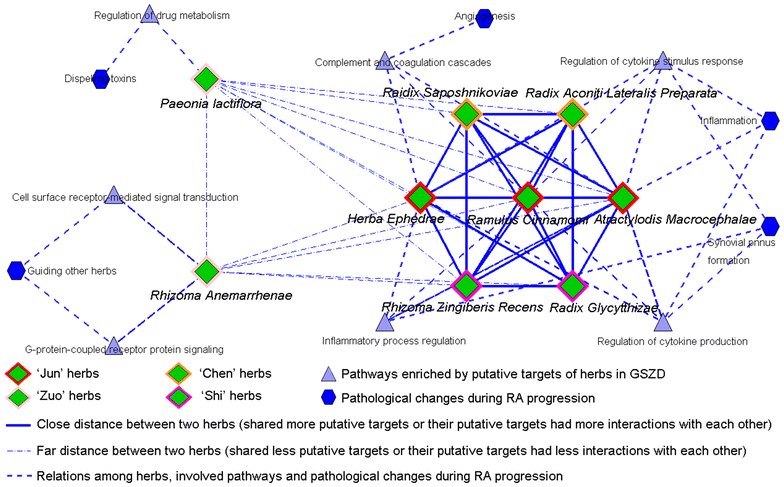
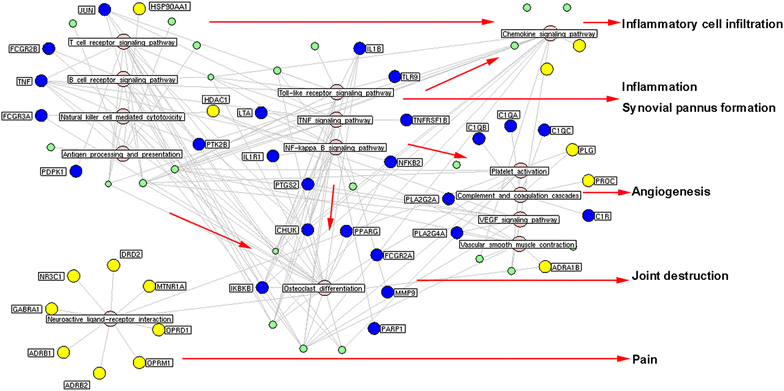
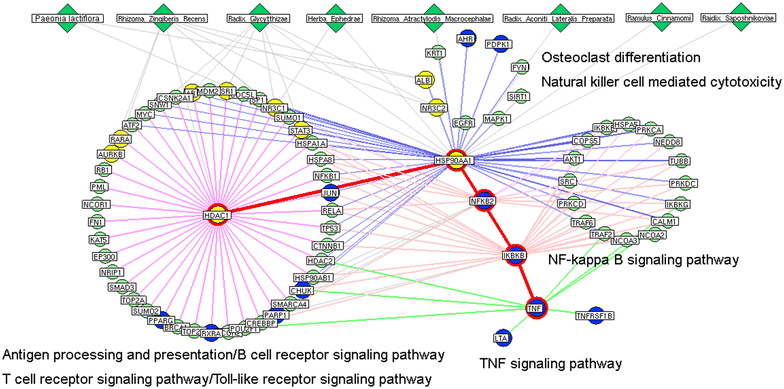
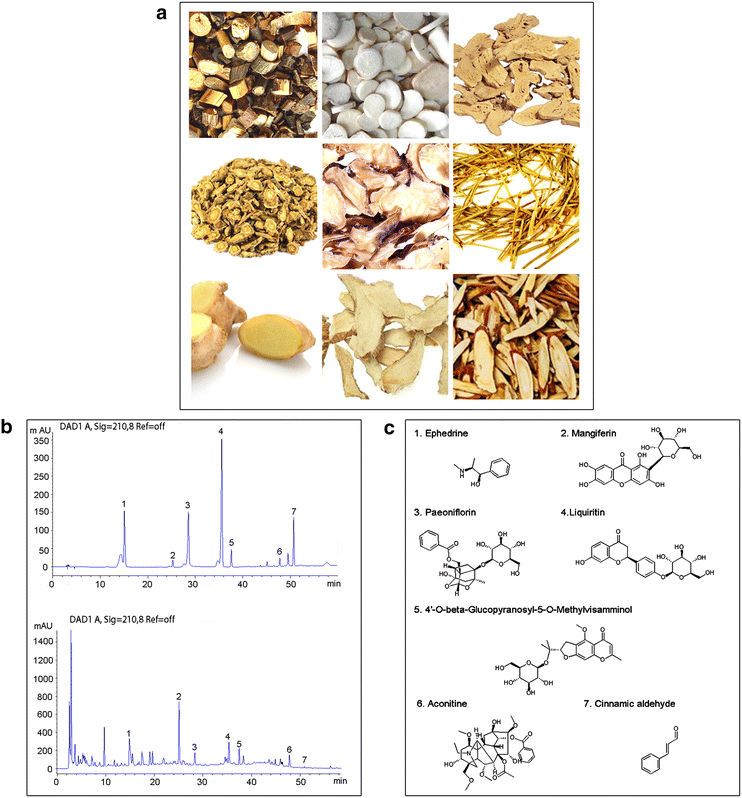
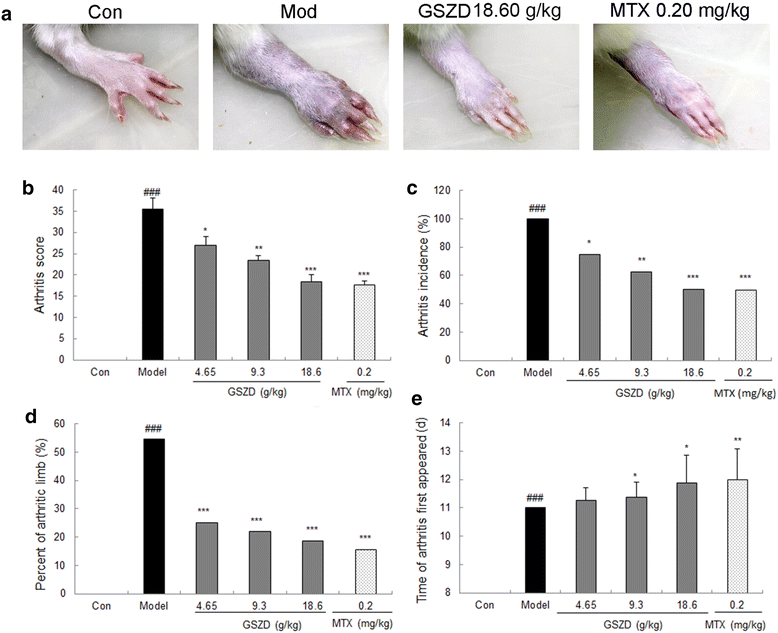
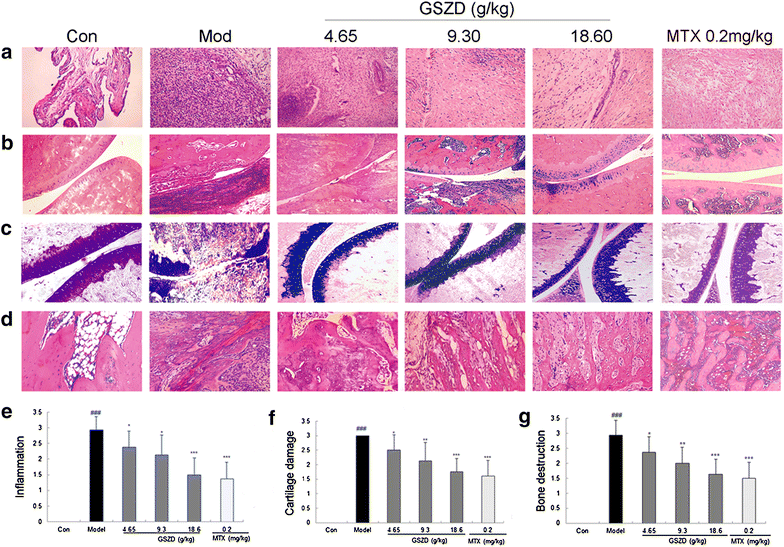
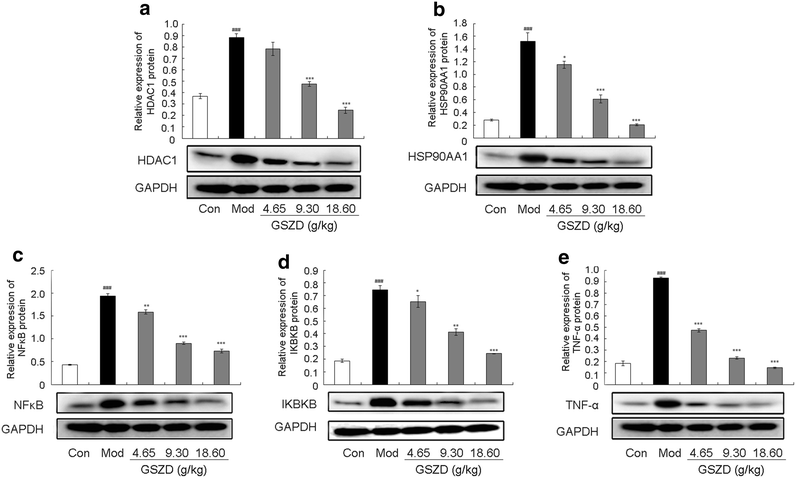

Similar articles
-
Guizhi-Shaoyao-Zhimu decoction attenuates bone erosion in rats that have collagen-induced arthritis via modulating NF-κB signalling to suppress osteoclastogenesis.Pharm Biol. 2021 Dec;59(1):262-274. doi: 10.1080/13880209.2021.1876100. Pharm Biol. 2021. PMID: 33626293 Free PMC article.
-
Guizhi-Shaoyao-Zhimu decoction possesses anti-arthritic effects on type II collagen-induced arthritis in rats via suppression of inflammatory reactions, inhibition of invasion & migration and induction of apoptosis in synovial fibroblasts.Biomed Pharmacother. 2019 Oct;118:109367. doi: 10.1016/j.biopha.2019.109367. Epub 2019 Aug 21. Biomed Pharmacother. 2019. PMID: 31545276
-
Guizhi Shaoyao Zhimu Decoction alleviates rheumatoid arthritis by inhibiting inflammation by targeting SLPI.Phytomedicine. 2025 Apr;139:156471. doi: 10.1016/j.phymed.2025.156471. Epub 2025 Feb 8. Phytomedicine. 2025. PMID: 39938174
-
Efficacy and tolerability of Guizhi-Shaoyao-Zhimu decoction in gout patients: a systematic review and Meta-analysis.Pharm Biol. 2020 Dec;58(1):1023-1034. doi: 10.1080/13880209.2020.1823426. Pharm Biol. 2020. PMID: 33205687 Free PMC article.
-
The treatment of rheumatoid arthritis using Chinese medicinal plants: From pharmacology to potential molecular mechanisms.J Ethnopharmacol. 2015 Dec 24;176:177-206. doi: 10.1016/j.jep.2015.10.010. Epub 2015 Oct 22. J Ethnopharmacol. 2015. PMID: 26471289 Review.
Cited by
-
Inducing Apoptosis and Suppressing Inflammatory Reactions in Synovial Fibroblasts are Two Important Ways for Guizhi-Shaoyao-Zhimu Decoction Against Rheumatoid Arthritis.J Inflamm Res. 2021 Jan 26;14:217-236. doi: 10.2147/JIR.S287242. eCollection 2021. J Inflamm Res. 2021. PMID: 33542641 Free PMC article.
-
Correction to: Guizhi-Shaoyao-Zhimu decoction attenuates rheumatoid arthritis partially by reversing inflammation-immune system imbalance.J Transl Med. 2020 Sep 29;18(1):372. doi: 10.1186/s12967-020-02536-0. J Transl Med. 2020. PMID: 32993688 Free PMC article.
-
Guizhi-Shaoyao-Zhimu decoction attenuates bone erosion in rats that have collagen-induced arthritis via modulating NF-κB signalling to suppress osteoclastogenesis.Pharm Biol. 2021 Dec;59(1):262-274. doi: 10.1080/13880209.2021.1876100. Pharm Biol. 2021. PMID: 33626293 Free PMC article.
-
Unveiling the Mechanism of Liangxue Siwu Decoction in Treating Rosacea Through Network Pharmacology and in-vitro Experimental Validation.J Inflamm Res. 2024 Aug 27;17:5685-5699. doi: 10.2147/JIR.S471097. eCollection 2024. J Inflamm Res. 2024. PMID: 39219817 Free PMC article.
-
Strychni Semen Combined with Atractylodes Macrocephala Koidz Attenuates Rheumatoid Arthritis by Regulating Apoptosis.Curr Comput Aided Drug Des. 2024;20(5):518-533. doi: 10.2174/1573409919666230807154555. Curr Comput Aided Drug Des. 2024. PMID: 37550914
References
-
- Urushibara M, Takayanagi H, Koga T, Kim S, Isobe M, Morishita Y, Nakagawa T, Löeffler M, Kodama T, Kurosawa H, Taniguchi T. The antirheumatic drug leflunomide inhibits osteoclastogenesis by interfering with receptor activator of NF-kappa B ligand-stimulated induction of nuclear factor of activated T cells c1. Arthritis Rheum. 2004;50:794–804. doi: 10.1002/art.20206. - DOI - PubMed
Publication types
MeSH terms
Substances
LinkOut - more resources
Full Text Sources
Other Literature Sources
Medical
Miscellaneous

